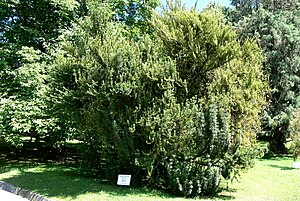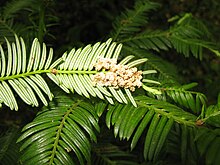Head clusters
| Head clusters | ||||||||||||
|---|---|---|---|---|---|---|---|---|---|---|---|---|

Japanese head yew ( Cephalotaxus harringtonia ) |
||||||||||||
| Systematics | ||||||||||||
|
||||||||||||
| Scientific name of the family | ||||||||||||
| Cephalotaxaceae | ||||||||||||
| Negroes | ||||||||||||
| Scientific name of the genus | ||||||||||||
| Cephalotaxus | ||||||||||||
| Sieve. & Zucc. ex Endl. |
The Kopfeiben or Plumeneiben ( Cephalotaxus ) are the only genus of the family of Kopfeibengewächse (Cephalotaxaceae). It contains about eleven species. Kopfeibe is the direct translation of the botanical genus name Cephalotaxus . Philipp Franz von Siebold sent the first specimens from Japan to Europe (Belgium) in 1829 , Cephalotaxus harringtonia .
description



Vegetative characteristics
The Kopfeiben species grow as evergreen, small trees or shrubs . The needles are arranged in a spiral on the branch , with lateral branches the needling can act in two lines. On the underside of the leaf, two stomatal ligaments are clearly recognizable, each consisting of 11 to 24 rows of stomata ; they usually appear white.
Generative characteristics
Cephalotaxus species are mostly dioecious ( dioecious ), rarely monoecious ( monoecious ), separate sexes. The male flowers are on branches of the previous year in groups of six to eight like heads together, mostly on a stem which is usually covered in a spiral with scales, each above a more or less egg-shaped bract. The male cone-like flowers contain 4 to 16 microsporophylls , each with usually three (rarely two or four) pollen sacs . The pollen is spread by the wind. The female cones stand on relatively long stems at the branch ends individually or up to six (rarely up to eight) together. In the female cones there are cross-opposite pairs of covering scales. Each cover scale has two axillary, upright ovules , of which usually only one develops. Seed scales are not recognizable in them. The pollination drop is relatively large and has a long shelf life. They bloom in spring and the seeds ripen the following year (in this they differ from the yew ( Taxus )).
The approximately 2 centimeters long seeds are surrounded by a seed coat ( arillus ). The plum-shaped aril is light brown or green and has an oval shape with a length of about 3 centimeters.
The germination is epigeal. The seedlings have two seed leaves ( cotyledons ).
Chromosome sets and ingredients
With n = 12 they have one of the largest sets of chromosomes within the coniferales . The ingredients include flavonoids , alkaloids and tropones , for example cephalotaxins and harringtonins.
Systematics, botanical history and distribution
Some species were previously described as Taxus . The genus Cephalotaxus was established in 1842 by Philipp Franz von Siebold and Joseph Gerhard Zuccarini in Stephan Ladislaus Endlicher : Genera Plantarum , Supplement 2, page 27. The family Cephalotaxaceae was published in 1907 by Franz Wilhelm Neger in Nadelhölzer , 23, 30.
The scope of the families Taxaceae and Cephalotaxaceae is discussed. Some authors also place amentotaxus in this family. According to some authors, three genera belong to the family Cephalotaxaceae. Other authors put Cephalotaxus as the sixth genus to the Taxaceae, so Cephalotaxaceae would only be a synonym of Taxaceae.
Cephalotaxus species are limited in their distribution to Asia . Six to seven species are native to China . In addition, head yams are also found in Korea , Japan , Burma , Laos , Vietnam , Malaysia and India .
Species of the head rasp prefer shady locations and usually grow in the undergrowth of forests. Their habitat are mainly mountain forests of moderate climates, where they stand together with deciduous trees .
The plant family of the Cephalotaxaceae used to have a much wider distribution with many species. At Fossils are known specimens from the Jura in Greenland, from the Miocene and Pliocene of Europe and northwestern North America.
There are eleven (eight to twelve) species of Cephalotaxus :
- Fortune's head yew ( Cephalotaxus fortunei Hook. ): The approximately two varieties thrive in China and northern Myanmar at altitudes of 200 to 3700 meters.
- Cephalotaxus griffithii Hook. : It is endemic to the Mishmi Mountains in Assam .
- Cephalotaxus hainanensis H.L.Li : It only occurs on Hainan Island and maybe in Guangdong and Guangxi .
- Japanese head yew or Harrington's head yew ( Cephalotaxus harringtonia (Knight ex J.Forbes) K.Koch ): Natural sites are in deciduous deciduous forests at altitudes of 600 to 1000 meters in Japan and Korea. There are about two varieties and many forms of culture, as this species has long been cultivated in Japan and China.
- Cephalotaxus koreana Nakai : The home is China and Korea .
- Cephalotaxus lanceolata K.M.Feng : It is endemic to northwestern Yunnan (Gongshan Drungzu Nuzu Zizhixian above Dulongjiang ) and northern Myanmar at altitudes of around 1900 meters.
- Cephalotaxus latifolia W.C. Cheng & LKFu ex LKFu et al. : It thrives in mountainous regions at altitudes of 900 to 2400 meters in China.
- Cephalotaxus mannii Hook. : It is endemic to the Khashia Mountains in India . In the Flora of China including Cephalotaxus hainanensis H.L.Li and Cephalotaxus griffithii Hook. then including their dissemination.
- Cephalotaxus oliveri Masters : It thrives at altitudes of 300 to 1800 meters in the Chinese provinces of northern Guangdong, Guizhou, western Hubei, Hunan, eastern Jiangxi, southern and western Sichuan and eastern Yunnan.
- Chinese head yew ( Cephalotaxus sinensis (Rehder & EHWilson) HLLi ): It thrives in China at altitudes of 600 and 2300 meters (in Yunnan up to 3200 meters).
- Cephalotaxus wilsoniana Hayata : It thrives at altitudes of 1400 to 3000 meters only in central and northern Taiwan (Formosa).
use
In some Cephalotaxus species, the wood is used as construction wood or as firewood. The wood from Cephalotaxus koreana is traded worldwide.
In India, the seeds are used to extract oil that is used medicinally. Some ingredients have been studied for their medicinal, especially anti- carcinogenic , effects.
The fully ripe aril of some species is eaten raw. Few species of seeds are eaten raw or cooked. Lamp oil can be obtained from the seeds of Cephalotaxus harringtonia var. Drupacea .
Some Cephalotaxus species and their cultivars are ornamental plants for parks and gardens. A conspicuous cultivar is the pillar head disk ( Cephalotaxus harringtonia 'Fastigiata').
swell
- Christopher J. Earle: Botanical information on the genus Cephalotaxus at www.conifers.org , The Gymnosperm Database , 2020.
- Liguo Fu, Nan Li, Robert R. Mill: Cephalotaxaceae. in the Flora of China , Volume 4: Cycadaceae through Fagaceae 1999: p. 85 ff Family, genus and Chinese species - online with the same text as the printed work.
- A. Bresinsky, Ch. Körner, JW Kadereit, G. Neuhaus, U. Sonnewald: Strasburger - Textbook of Botany , 36th Edition, Spectrum Academic Publishing House, Heidelberg 2008. ISBN 978-3-8274-1455-7 , p. 840 .
- Kim E. Trip: Cephalotaxus: the plum yews. In: Arnoldia , Volume 55, Issue 1, 1995, pp. 24-39: PDF. (PDF; 1.2 MB)
literature
- Colin Tudge : The secret life of trees , Penguin books, London 2006, ISBN 978-0-14-101293-3 .
Individual evidence
- ↑ Christopher J. Earle: Botanical information on the genus Cephalotaxus at www.conifers.org , The Gymnosperm Database , 2020.
- ↑ Cephalotaxus harringtonia drupacea at Plants For A Future . Retrieved March 14, 2014.

